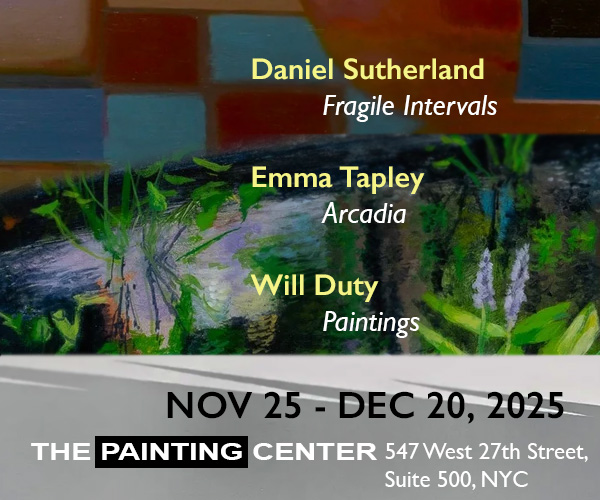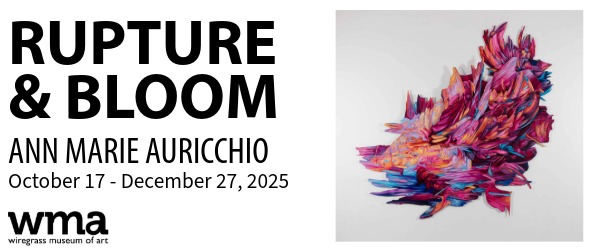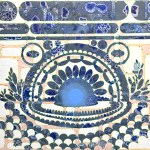
Contributed by Adam Simon / Lineage is not a concept with a lot of currency these days; too close, perhaps, to its more d�class� kissing cousin, tradition. We look to academia and art history to find precursors for artistic innovators. Typically, the presentation and criticism of art tend to focus on the artist as a singular creator, so it�s a welcome surprise to come across an exhibition that not only tackles the concept of lineage, but also does so by presenting it as an open question, an armature on which to hang a compelling show. The artists in �Semi Autonomous Bodies,� on view at PS 122 through October 13, are all connected through circumstance: the artist Spencer Hinson was a student and project assistant of Tom McGrath, who was a student of Lydia Dona, who was a student of Ron Gorchov, whose long-time studio assistant is Olga Sophie Kauppinen.
For the curator, Ian Cofre, this was sufficient reason to present current work by each of these artists. It�s up to us as viewers to decide if there is a consistent thread, whether actual lineage is in evidence, or mere proximity. As Cofre himself put it, �There is definitely something connecting these artworks. It may not be visible.�

For me, the clearest visible connection is between the work of Olga Sophie Kauppinen and Ron Gorchov, attributable, perhaps, to the fact that they both employ shaped canvases. Their personal connection is also ongoing, and the longest running of the group. Working with or for Gorchov is Kauppinen�s day job (Could another subject for an exhibition be the effect of artists� day jobs on their art?). Her painting is a vibrant swirl of decal-like forms against a green-blue ground, with enough of a landscape feel to make for an inspired pairing with what is the only other painting in the first of two rooms, a more literal landscape by Tom McGrath.

Tom McGrath Grey Thermachrome (No. 6 � Climate Changing Landscape Paintings), ?2019, Leuco-based thermo sensitive pigment, acrylic and vinyl polymer on canvas, ?18 x 24 inches
McGrath�s painting was made using thermo sensitive pigment, which means that the colors shift slightly according to the temperature in the room. Both of McGrath�s paintings in the show rely on chemical reactions of unconventional materials, effectively repositioning the landscape genre to include both present-day climate realities and a sense of unlimited formal possibility.

30 x 30 inches
Representing the artist Lydia Dona are two square paintings, for her modest in scale, that run the gamut of painterly gestures and devices. The overall feel is of syntactical forms with combinatory power as specific, and as capable of communicating, as languages that employ words.
Ron Gorchov�s single painting in the exhibition is from this year (as are almost all of the works in the show). Gorchov concurrently has a solo exhibition at Cheim & Read on 67th Street. This painting feels iconic for the exhibition, characteristically presenting two forms against a limpid wash of yellow and white. The forms feel provisional, with tentative under-drawing made visible; a relationship in an exhibition based on relationships.

Finally, there is a piece, not a painting, easily missed, by Spencer Hinson. Here is where any viewer searching for an actual connecting thread, actual lineage or influence, would be stumped. The work consists of an actual sock, which sits on the window ledge. It is a very quiet presence that derives its power from its context or from being �out of� context. It bears a faint resemblance to one of the forms in the Gorchov in the same room. When pressed, Ian Cofre allowed that Hinson�s artwork had a personal, and historical connection to the work of Tom McGrath. It is a connection that may not be visible.
Which brings us back to the odd title of the show: SEMI AUTONOMOUS BODIES, and the central question, as posed in the press release: ��is there shared DNA represented here?� Are the bodies that are semi-autonomous, as referred to in the title, the bodies of the artists, or are the bodies the artworks themselves? Is semi-autonomous the same as connected? If the artists are connected through circumstance, or through dialog and exchange, are the objects they produce inherently connected? And if these objects are connected, must it be visible?
No experience of viewing art is ever pure. We look at objects in a gallery or museum differently from those we see at an outdoor fair with booths, and we view the work of a known artist differently from someone unknown. Any foreknowledge colors our experience of looking. I suspect that the title is odd enough to lead most visitors to at least scan the press release. I had an uncanny sense of being privy to a kind of leisurely, drawn-out conversation between the works in this exhibition, where everyone gets to speak, without being interrupted, and everything said is of interest.
�SEMI AUTONOMOUS BODIES,� curated by Ian Cofre. PS 122 Gallery, 150 First Avenue, NYC, entrance on 9th St., New York, NY. Through October 13, 2019.
About the author: Adam Simon is affiliated with Studio 10 in Bushwick. His most recent solo show, �From this Position,� took place earlier this year.
Related posts:























Wonderful writing by Adam Simon. I suggest he pursue more essays like this as I believe art writing may be his prime contribution to contemporary art.
It takes a true artist to see the beauty in the mundane and simple. This is the case here. I mean, a gray sock with a hole in it, who thinks of this? It’s simple yet profound in its basicness.
I’ll take that as a compliment, Larry, which I strongly disagree with.